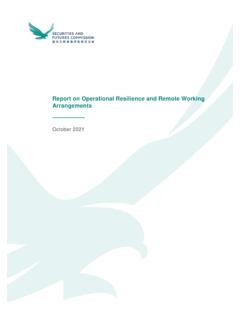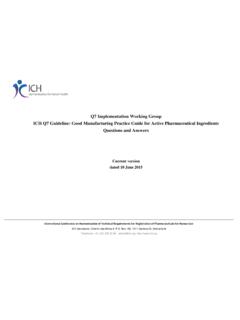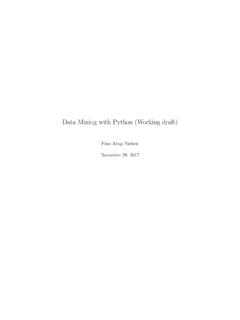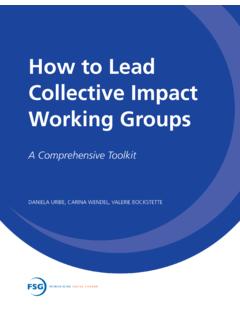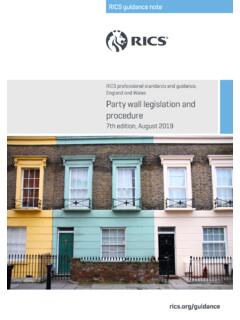Transcription of Guidelines for the management of norovirus outbreaks in ...
1 Guidelines for the management of norovirus outbreaks in acute and community health and social care settings Produced by the norovirus working party : an equal partnership of professional organisations Guidelines for the management of norovirus outbreaks in acute and community health and social care settings Contents Scope .. 3. 4. 6. The Guidelines .. 7. Hospital Design .. 7. Organisational Preparedness .. 7. Defining the start of an outbreak and Period of Increased Incidence (PII) .. 9. Defining the end of an outbreak .. 10. Actions to be taken during a Period of Increased Incidence (PII).. 10. Actions to be taken when an outbreak is 11. Actions to be taken when an outbreak is over .. 12. The IPC management of suspected and confirmed cases .. 12. The role of the laboratory .. 15. Avoidance of admission .. 16. Clinical treatment of norovirus .. 16.
2 Patient discharge .. 17. Environmental decontamination .. 17. Increased frequency of decontamination .. 18. Disinfection .. 18. Prompt clearance of soiling and spillages .. 19. Laundry .. 19. Terminal cleaning following discharge or transfer of patient, or resolution of symptoms for 48 20. Visitors .. 22. Staff considerations .. 22. Communications .. 23. Surveillance .. 23. 1. Guidelines for the management of norovirus outbreaks in acute and community health and social care settings The management of outbreaks in Nursing and Residential Homes .. 25. Importance of 25. Defining the Start and the End of an 25. Actions to be taken when an outbreak is suspected .. 25. Actions to be taken when an outbreak is 25. Actions to be taken when an outbreak is over .. 26. The IPC management of suspected and confirmed cases .. 26. The role of the laboratory.
3 26. Cleaning of the 26. Handwashing 27. Laundry .. 27. Visitors .. 28. Staff considerations .. 28. Prevention of hospital 29. Residents discharged from hospital .. 29. Acknowledgments .. 30. 31. Appendix 34. Appendix 2: List of Stakeholder 35. Partner Organizations: .. 35. External Stakeholders: .. 35. Appendix 36. Appendix 4: Key Recommendations .. 37. 2. Guidelines for the management of norovirus outbreaks in acute and community health and social care settings Scope This guidance gives recommendations on the management of outbreaks of vomiting and/or diarrhoea in hospitals and community health and social care settings, including nursing and residential homes. They are not specifically intended to cover schools, colleges, prisons, military establishments, hotels or shipping although there will be some generalisable principles that will be of use in managing outbreaks in those institutions.
4 There are other causes of vomiting and/or diarrhoea outbreaks and the guidance will apply to all viral gastroenteritides. However, the principal and most common cause of such outbreaks is norovirus which is one of the most infective agents seen in health and social care establishments (1) and the title reflects this. Food borne norovirus outbreaks require investigation and management according to other appropriate guidance and procedures. The scope is derived from the outcome of a Department of Health workshop held on 16 July 2010 and attended by representatives from a wide range of stakeholders including the partner organisations involved in the production of these Guidelines . 3. Guidelines for the management of norovirus outbreaks in acute and community health and social care settings Introduction norovirus is estimated to cost the NHS in excess of 100 million per annum (2002-2003 figures) in years of high incidence (2).
5 Approximately 3000 people a year are admitted to hospital with norovirus in England (3). and the incidence in the community is thought to be about of the 17 million cases of Infectious Intestinal Disease in England per year. and there is evidence that this burden has increased over the past decade (4). Figure 1. Laboratory reports of norovirus 2000 - 2011. England and Wales There are two main factors that underpin the need for new guidance: The large burden of norovirus disease that the NHS and other organisations have experienced recently. Figure 1 shows laboratory reports which have also increased, although this is at least partly attributable to wider usage of norovirus testing (5). The organisational and operational systems in the modern NHS and the need for the efficient and safe care of patients within a safe environment. This guidance is based on a principle of minimising the disruption to important and essential services and maximising the ability of organisations to deliver appropriate care to patients safely and effectively.
6 There is a shift of focus towards a balance between the prevention of spread of infection and maintaining organisational activity. In effect, this means a move away from the traditional approach of complete ward closure and an adoption of a pragmatic, escalatory system of isolation using single rooms and cohort 4. Guidelines for the management of norovirus outbreaks in acute and community health and social care settings nursing without compromising patient care both for norovirus itself and other essential healthcare. This is a key difference to previous guidance of the Public Health Laboratory Service working party published in 2000 (6). The PHLS guidance was supported by the subsequent work of Lopman which showed an approximate halving of the duration of outbreaks if wards were closed within 3 days of the start of an outbreak when compared to those which were closed after greater than 3 days (2).
7 However, the working party noted that the number of outbreaks which led to closures within 3 days was only 7 (compared to 76 after 3 days). and at least one of those 7 outbreaks could be described as atypical. A more recent meta-analysis by Harris, Lopman and O'Brien of 72 outbreaks internationally, showed that there was no evidence for the effectiveness of any particular Infection Prevention and Control (IPC) interventions in the management of outbreaks (7). In addition to much anecdotal evidence that closure of smaller clinical areas can succeed in controlling outbreaks , there is one recent study which also supports this strategy (8). In this study, 41 confirmed outbreaks in 2007-2008 were managed by ward closures and 19 outbreaks in 2009-2010 were managed by closure of bays with doors. There were statistically significant differences in the frequency of outbreaks , numbers of bed days lost per outbreak ( v ) and the duration of outbreaks ( v ).
8 These new Guidelines also emphasise the importance of organisational preparedness for outbreaks . The epidemiology of norovirus changes over time and geography. The emergence of new strains will continue to challenge us as populations at risk, including employees of affected organisations, will also change. Meeting these challenges will require robust surveillance of outbreaks and sentinel surveillance of norovirus activity in organisations and the wider community even though there is presently only very low quality evidence that surveillance prevents symptomatic norovirus infection and no evidence that it either prevents or shortens outbreaks (9). The role of the laboratory is of considerable interest to those involved in the investigation and management of outbreaks and guidance is included on the appropriate use of norovirus testing. 5. Guidelines for the management of norovirus outbreaks in acute and community health and social care settings Methodology The guidance has been written by a multi-agency working party the members of which acted as representatives of their respective organisations.
9 An important factor was the full involvement of NHS. management representation through the NHS Confederation. It is anticipated that joint ownership of this guidance between IPC practitioners and the managerial sector will reduce conflicts of interest and tensions within organisations. Differing patterns and dynamics of outbreaks will require different, tailored, IPC responses which may be misconstrued as inconsistency of approach and it is, therefore, important that the underlying principles are understood by all sections and levels of an affected organisation. Patient involvement was achieved through the inclusion of the National Concern for Healthcare Infections. The partner organisations and their representatives are listed in Appendix 1. The councils or boards of partner organisations participated in a first consultation (Consultation 1) which set the foundations for the development of a draft document which was then sent to the partner organisation memberships and all stakeholder organisations for their comments (Consultation 2).
10 Detailed involvement of representatives of the community sector took place after Consultation 1 and they were fully involved in the writing of the draft document for Consultation 2 and in the production of the final Guidelines . The working party also included the Director of the Sowerby Centre for Health Informatics at Newcastle (SCHIN) who advised on literature searches and the evaluation of the evidence base. SCHIN was also commissioned to undertake the literature searches. These were carried out in August and September 2010. It is important to note that high quality evidence is lacking for most aspects of norovirus outbreak management . The recommendations of the working party are based as far as possible on available evidence and, where there is little or no evidence, the guidance is written according to the underlying principle of a pragmatic approach to the delivery of IPC in a modern NHS, based upon practical experience, and by using an informal Delphi process to achieve consensus (10).










